Recent Articles
Popular Makes
Body Types
2021 Toyota Prius Road Test and Review
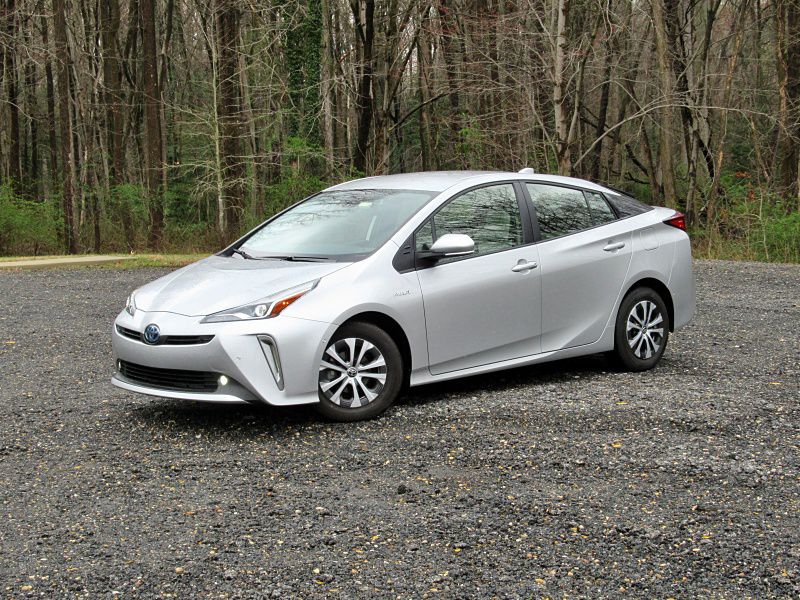
2021 Toyota Prius XLE ・ Photo by Brady Holt
The Toyota Prius used to be the cutting edge of fuel savings. As futuristic as it was fuel-efficient, it introduced America to the idea of a gas-electric hybrid. Commuters and celebrities alike were on waiting lists for the high-mileage hatchback.
Sales have dwindled in recent years, though. Gas prices take the sting out of America’s SUV habit, and modern crossover models burn less fuel than before. Toyota also lets you choose from a wide range of hybrid models beyond the Prius, including nearly all sizes of sedans, SUVs, and minivans. And as the cutting edge has moved away from hybrids toward fully electric vehicles that cut out gasoline entirely, the celebrities and waiting lists have followed. We just spent a week in the 2021 Toyota Prius to see if this compact hybrid — now priced from $24,525 — still has a purpose in today’s new environment. Here’s what we found.
How It Works
After two decades of Prius sales, many car buyers are already familiar with how hybrids work. But let’s quickly go over the basics.
The Prius has both a gasoline engine and an electric motor, making a combined 121 horsepower. An onboard battery powers the electric motor, which can either help the gasoline engine accelerate or take over entirely when you’re cruising or accelerating very gently. This electric assistance means the gasoline engine needs to run less, reducing fuel usage. To recharge, the battery captures energy from the gasoline engine and the friction of operating the brakes. Most Priuses are front-wheel drive; an optional all-wheel-drive system adds a second electric motor to power the rear wheels, improving traction in slippery conditions. Extra-thrifty buyers can also consider the Toyota Prius Prime, a plug-in hybrid with a larger electric battery that you can recharge from the grid for an EPA-estimated 25 miles of gas-free driving. Once that range is used up, the Prime then operates like a standard Prius hybrid.
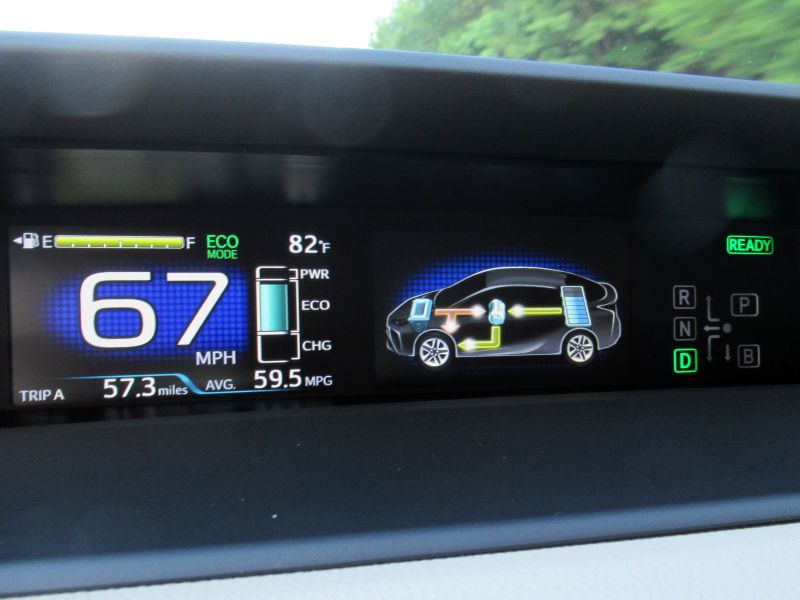
Photo by Brady Holt
Phenomenal Efficiency
The 2021 Toyota Prius is one of the most fuel-efficient cars you don’t have to plug in. In EPA testing, it scores between 49 mpg and 56 mpg in mixed driving, depending on the powertrain and trim level. Only one other vehicle, the slightly smaller Hyundai Ioniq, fares better. What’s more, we’ve found that extra-attentive driving lets you beat the EPA estimates more easily than in the Hyundai because you can accelerate the Prius more with the gas engine off. We tested an AWD model that the EPA pegs at 49 mpg, and we managed 61 mpg in a week of mixed driving — about 54 mpg on the open freeway but the upper 60s at lower speeds. Even for a drive where we experimentally floored the throttle at every opportunity rather than feathering it, the trip computer stubbornly reported 60.5 mpg.
Still, while some modern fuel-sippers are fast as well as economical, the Prius is decidedly not. With just 121 horsepower, this is no Tesla, or even a Toyota Camry Hybrid or Toyota RAV4 Hybrid (which both make more than 200 hp). When you do need the gasoline engine, it wakes up with an unsubtle moan and vibration; the Prius is not dangerously slow, but it’s happiest when the driver is in no hurry. And its mileage advantage shrinks on the highway, where the non-hybrid cars reach peak efficiency yet the Prius can benefit less from its electric assistance.
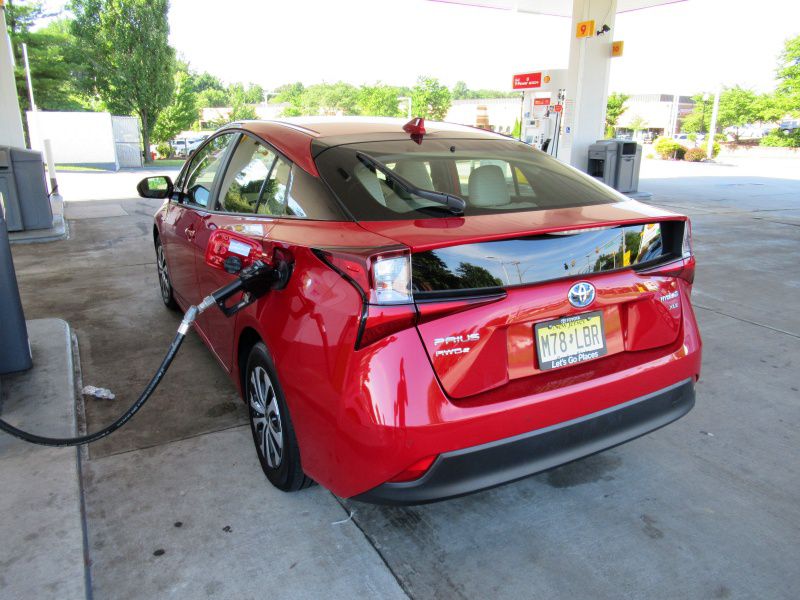
Photo by Brady Holt
Refusing to Blend In
Prius sales took off in 2004 when Toyota created its iconic futuristic hatchback shape, and a unique design has continued to be central to the model’s identity. That’s no different for the current generation, which debuted in 2016. Angles and wedges dash decorate a body that’s designed to prioritize aerodynamics.
A 2019 styling update did clean up some of the most controversial details, creating simpler headlight and taillight designs. But the Prius almost looks like yesterday’s idea of the future. It’s busy and arguably awkward, while trendy EVs are more likely to favor elegant simplicity. It also stands out from other hybrids, as most hide their gas-electric components in wholly conventional bodies. Even Toyota’s other hybrid-only models — the Venza crossover and Sienna minivan — look like normal vehicles.
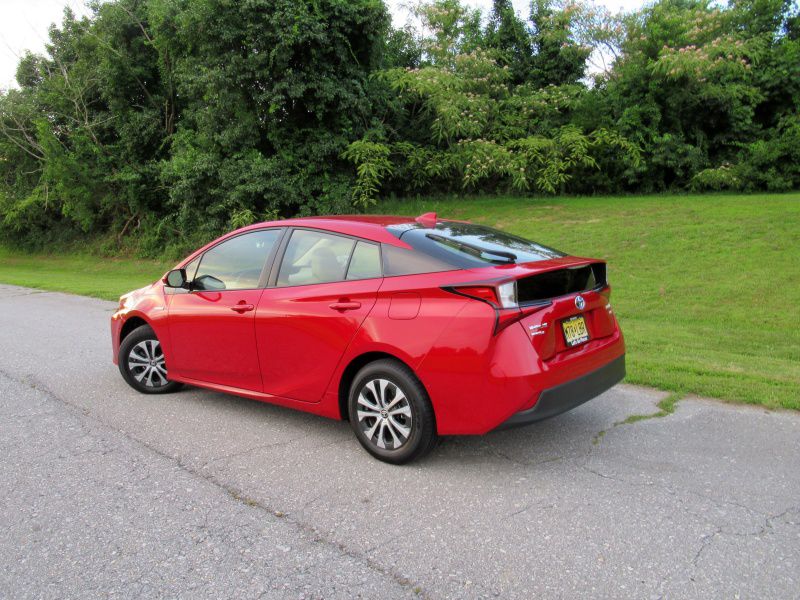
Photo by Brady Holt
Funky Interior
A Tesla’s interior is polarizing. You get a steering wheel and a big touchscreen, and not much else. Whether you find it refreshingly simple or distracting to operate, it’s unquestionably advanced. The Toyota Prius interior, while also polarizing, is not.
Toyota has updated the interior a bit since 2016, but only to what would have been considered competitive in 2016. Last year brought a 7-inch touchscreen instead of a 6-inch unit, and it added Apple CarPlay smartphone integration. This year, the system adds Android Auto. But the screen is still smaller than today’s norm of 8 to 9 inches, which is an odd omission in the high-tech Prius, and it doesn't respond especially quickly. The top Prius Limited model does have a big 11.6-inch screen, but it loses Andriod Auto functionality and has dated graphics. Keeping things funky (if not quite advanced) are two longtime Prius staples: a center-mounted digital speedometer and an electronic gear selector. Overall interior quality is good for an economy car, with a mix of ordinary plastics and nicely textured padded surfaces. We also liked the two-tone leatherette upholstery in our test vehicle. The foot-operated parking brake is an old-school relic, though; most Toyotas have moved to an electronic switch, and once again, it seems odd that the Prius misses that opportunity.
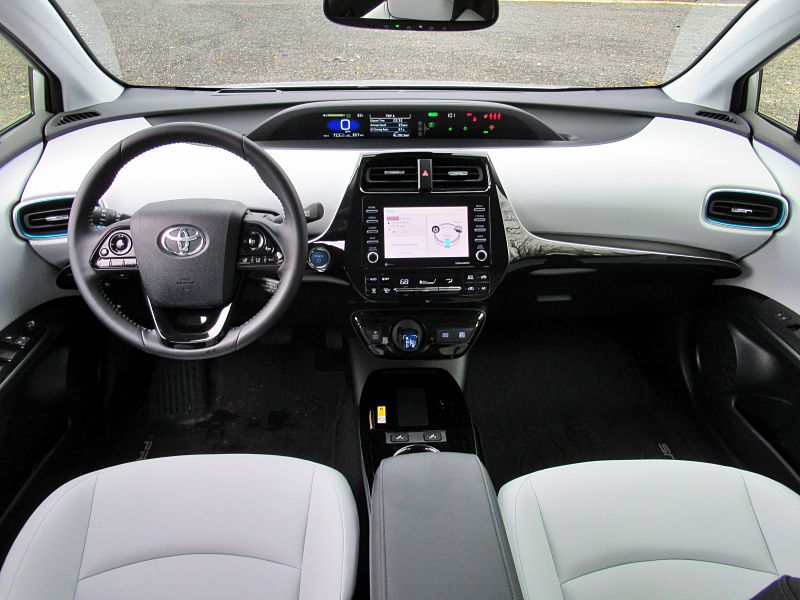
Photo by Brady Holt
Usefully Spacious
While many cars are fuel-efficient, many fuel-efficient cars have cramped interiors. That’s no longer a given, thanks to the variety of hybrids and electric vehicles available today, but the Prius delivers plenty of versatility.
First of all, unlike the competing Honda Insight or the Toyota Corolla Hybrid, it’s a five-door hatchback. That means when you fold down the rear seat, you get a big, open cargo hold. You get 27.4 cubic feet of cargo space behind the rear seat and 50.7 cubic feet with the rear seat folded down, which is more than some subcompact SUVs. The low seats aren’t SUV-like, but adults can get comfortable in both the front and the back.
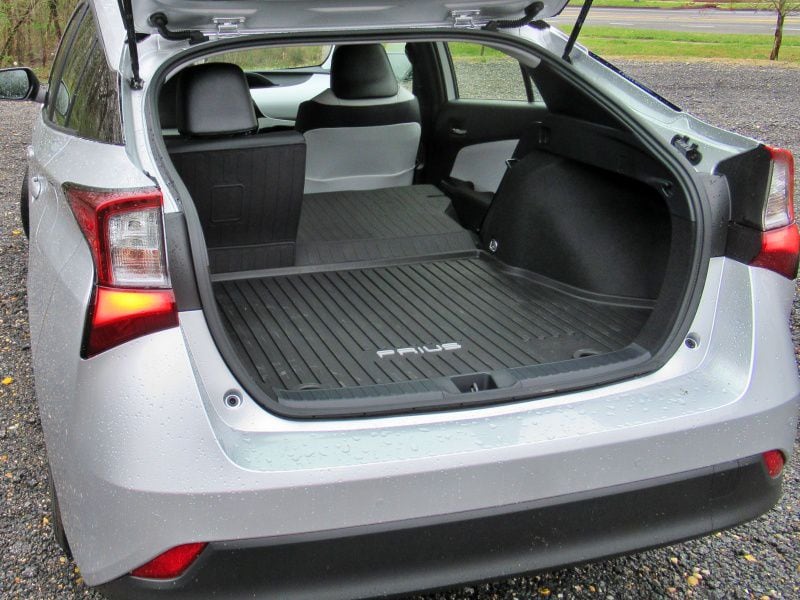
Photo by Brady Holt
Decent Ride and Handling
The Prius has never been known for being a fun, sporty car. But the latest generation brings it closer to that mark, as long as you’re willing to forgive the sluggish, noisy acceleration.
Today’s Prius delivers a smoother, more stable ride and more agile handling than earlier generations. If you’ve driven a Prius from before 2016, you experienced a vehicle with less body control and might want to give it another chance. Still, while this was a revolutionary improvement in 2016, standards have continued to evolve. Now the Prius’s ride and handling are more unobjectionable than impressive, with a rubbery steering feel that can also feel a touch too heavy at low speeds. A noisy engine detracts from the ambiance further. The competing Hyundai Ioniq delivers a more refined driving experience.
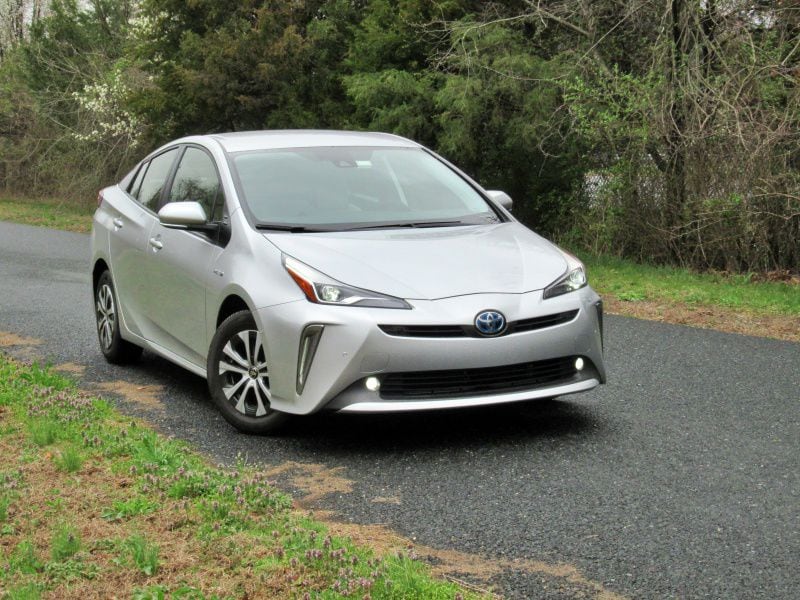
Photo by Brady Holt
Not the Cheapest Small Car
Priced from $24,525, the Prius isn’t a cheap car. However, its price has grown less over the years than most cars. The first 2001 Prius stickered at $19,995. In comparison, the 2001 Toyota Corolla started at $12,568 versus $20,025 today.
What’s more, the 2021 Prius has added a lot of equipment to compensate for its price jump. It has contemporary infotainment and safety technology that couldn’t even be fathomed 20 years ago. It also has more standard safety features than most relatively affordable cars, including automatic emergency braking, adaptive cruise control, lane-keep assist, and — new this year — bicyclist detection and low-light pedestrian detection. It’s easy to push the price past $30,000 if you want leatherette upholstery, a power driver’s seat, heated front seats, a heated steering wheel, a wireless smartphone charger, and all-wheel drive; so equipped, the Prius starts at $29,875 plus a $995 destination charge. And the top Limited model starts at $32,650 with a premium sound system and the big touchscreen. Any Prius costs a few thousand dollars extra compared with an ordinary compact car, but the more features you add, the more glaring its downscale refinement becomes.
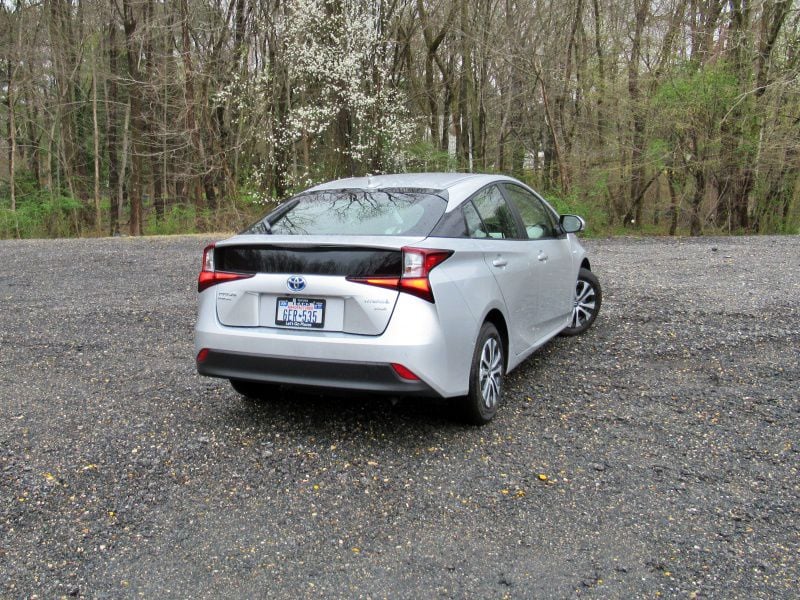
Photo by Brady Holt
Competitors to Consider
The most tempting Prius competitors are in the same Toyota showroom. The first is the Prius Prime plug-in hybrid, since it uses even less gasoline and — when you factor in a $4,502 federal tax credit — costs less than the regular Prius hybrid. Plus, when you operate it on pure electricity, you don’t hear the Prius’s noisy engine. The Prime even has arguably more attractive styling. The downsides include a little less rear-seat and cargo space, no available all-wheel drive, and broader use of the bigger, less functional touchscreen.
Meanwhile, the Toyota Corolla Hybrid, which has the same mechanical components and nearly identical mileage to the Prius but in a conventional sedan wrapper. The Toyota Camry Hybrid is bigger, cushier, and more powerful than the Prius, and also quite efficient, but it costs about $3,000 more. Another grand gets Toyota’s best-selling hybrid, the RAV4 Hybrid SUV, which is roomier but gets “only” 40 mpg. Outside the Toyota brand, the Prius competes most against the Hyundai Ioniq hatchback and Honda Insight sedan. Both feel fancier than the Prius despite costing less, and they offer equivalent or better EPA ratings, but the Prius trumps their real-world interior space and fuel economy. And they don’t offer AWD.
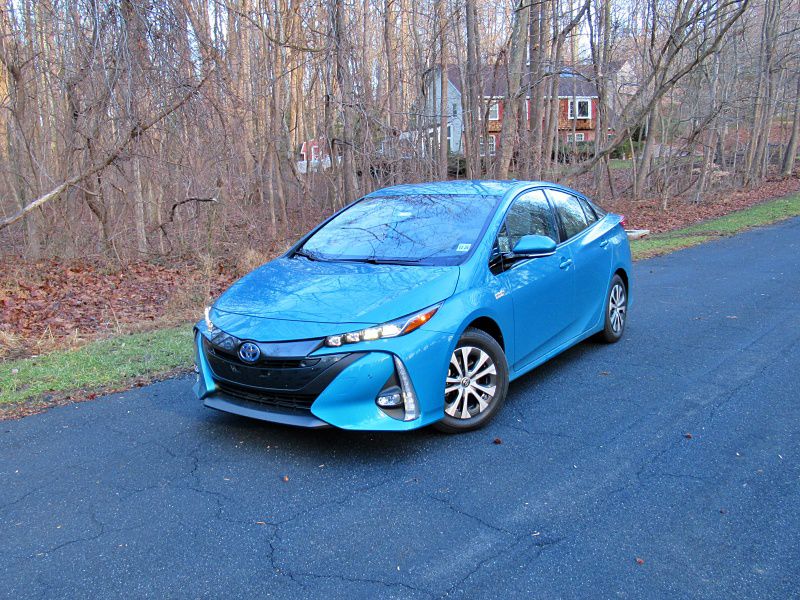
Photo by Brady Holt
Still Has a Purpose
Even in a world of Teslas and SUVs, the 2021 Toyota Prius has a clear place. It’s functional yet it’s fuel-efficient, and you refuel it in five minutes at any gas station. And while it’s neither sporty nor luxurious, it’s serviceable transportation that avoids feeling ridiculously cheap or unpleasant. Plus, some drivers will truly enjoy milking every last mile from a gallon of gasoline.
It’s not for everyone. If you want your car to be fast, cool, or filled with snazzy tech toys, the Prius won’t deliver. If you do most of your driving at high speeds, you won’t realize the maximum fuel-saving potential. And if you’re ready to skip gasoline entirely, you’re in the wrong place. But if you’re looking for a convenient commuting appliance that will sip fuel even in grueling stop-and-go traffic, the Prius can still serve you well.
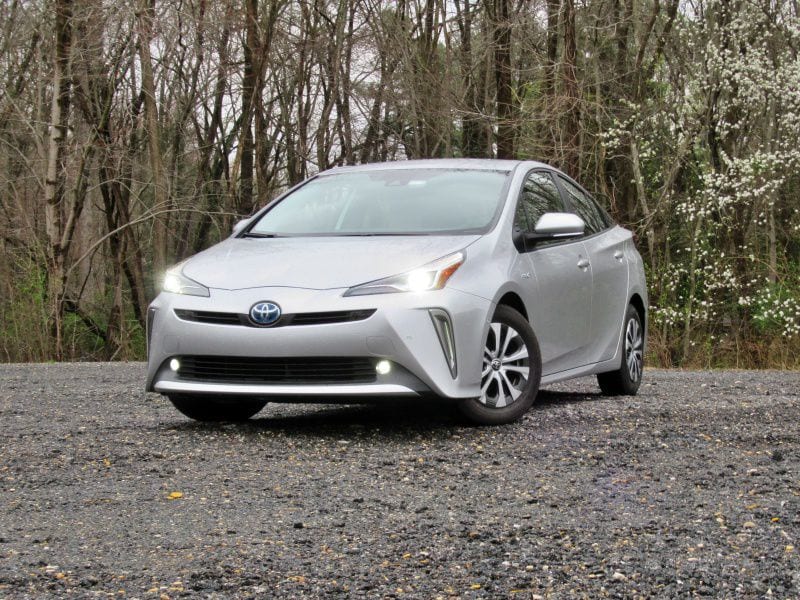
Photo by Brady Holt